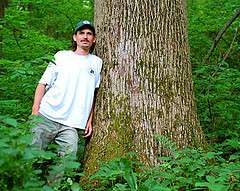Research suggests 'conservation through cultivation' may save ginseng

(PhysOrg.com) -- American ginseng has been collected from Pennsylvania forestlands for more than 250 years, but Penn State researcher Eric Burkhart was astonished by how little was known about the industry focused on the gathering of a wild herb.
Eight years or so ago, when the then-graduate student in the College of Agricultural Sciences began his investigation into Panax quinquefolius L. (Araliaceae) in the commonwealth, there were growing concerns about the sustainability of continued wild extraction.
Those concerns remain, but today, thanks to Burkhart's work, much more is known about the status of the slow-growing, perennial plant in the Keystone State. That information -- along with a proposal for forest-based cultivation of ginseng -- is detailed in his doctoral dissertation titled, "Conservation Through Cultivation: Economic, Socio-Political and Ecological Considerations Regarding the Adoption of Ginseng Forest Farming in Pennsylvania."
American ginseng is in high demand in the United States and China as an herbal remedy. It is used to combat stress and to increase energy and mental acuity, according to Burkhart, of Pennsylvania Furnace, who this spring received his doctorate from the college's School of Forest Resources.
However, most wild ginseng is exported to the Orient, where it is highly valued as a "tonifying" or "adaptogenic" herb. Burkhart said as much as 4,000 pounds of wild ginseng roots are exported from Pennsylvania each year, at $400-$1,000 per pound, representing one of Pennsylvania's most unusual but little-acknowledged industries.
In general, the species has been affected adversely by habitat loss and over-collecting for commercial purposes, and as a result, many states, such as Maryland, require a permit for wild ginseng collectors. However, Burkhart, who is program director of plant science at Shaver's Creek Environmental Center, was interested in exploring other approaches to ginseng conservation.
"Conservation through cultivation is an approach to wild-plant conservation in which individuals are encouraged and/or facilitated to transition from a purely extractive-based exploitation -- wild harvesting -- to a more intentional and sustainable plant husbandry," he explained. "The approach has been used elsewhere in the world to conserve wild plants and animals while also providing economic opportunities to landowners."
But there were many unanswered questions that Burkhart felt were important to address in order to support this transition, so he studied economic, socio-political and ecological aspects of forest-based production of ginseng in Pennsylvania.
Between 2002 and 2009, he surveyed ginseng sellers (collectors and growers) and dealers, conducted field habitat studies and performed financial modeling to develop information pertinent to managing, sustaining and possibly expanding this industry through agroforestry cultivation.
"Results from these data-collection efforts indicate excellent potential for a conservation-through-cultivation approach to help conserve ginseng in Pennsylvania, while providing economic opportunities to forest landowners," Burkhart said. "However, key challenges exist with regard to socio-political aspects of this transition."
One of the challenges Burkhart identified is that while efforts to "manage" and conserve ginseng in the state generally are supported by stakeholders, those who already are growing or managing ginseng on their forestlands are concerned about increased government involvement through additional regulations and/or taxation.
He noted that another key challenge is the "variety of husbandry activities already used to produce 'wild' ginseng, ranging from intensive forest farming to casual seed stocking in select forested areas."
This creates a complex management scenario for the Pennsylvania Department of Conservation and Natural Resources, which generally has managed the plant and the industry with the presumption that all 'wild' product entering the trade is, indeed, truly wild.
"Existing wild ginseng root exports already consist of a mix of collected and husbanded product. Some ginseng producers are striving for greater recognition and legitimacy -- while others would like to remain under the radar," Burkhart said.
These and other related findings suggest that government agencies, such as the DCNR, should work to develop mechanisms and processes for improved -- more accurate and less cumbersome -- industry tracking and enforcement, Burkhart contended.
"The financial models I developed indicate that ginseng is one of the few native medicinal plants that can be cultivated commercially and profitably as part of agroforestry ecosystems in Pennsylvania," he said.
"My research indicates that ginseng conservation through cultivation can result in long-term sustainability of the industry in Pennsylvania, as long as appropriate steps are taken to accommodate and nurture this unique and evolving industry."
Provided by Pennsylvania State University

















